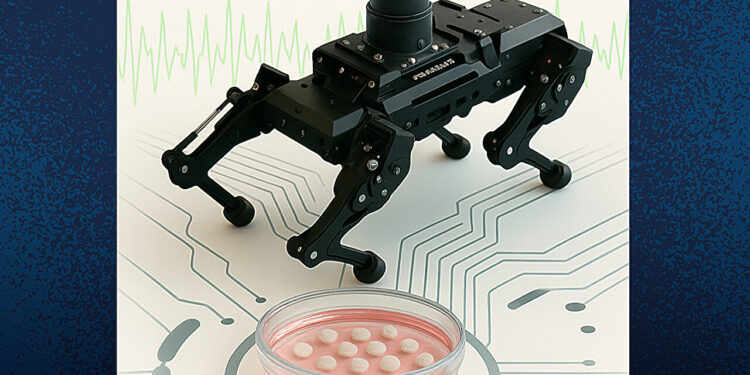Gramos works using the unique optorelectronic properties of the graphene to convert light into soft electrical indices that encourage neurons to connect and communicate. Credit: Wirla Pontes
Researchers from the University of California San Diego Sanford Stem Cell Institute have developed a new method to stimulate and mature human cerebral organoids using graphene, a carbon leaf at an atom.
Published in Nature communicationsThe study introduces optical stimulation mediated by graphene (Gramos), a safe, non -genetic, biocompatible way and not damaging to influence neural activity over the days of weeks. The approach accelerates the development of brain organoids, in particular important for the modeling of age -related conditions such as Alzheimer’s disease – and even allows them to control robotic devices in real time.
“This changes the situation for research on the brain,” said Alysson Muotri, Ph.D., corresponding author, professor of pediatrics, and director of the UC San Diego Sanford Stem Cell Institute Integrated Space Stem Cell Orbital Research Center.
“We can now speed up the maturation of brain organoids without modifying their genetic code, by opening doors for research on diseases, brain-machine interfaces and other systems combining living brain cells with technology.”
A more intelligent way to grow the brain in a dish
Brain organoids – three -dimensional models derived from stem cells of the human brain – are precious to study neurological diseases, but they generally ripen slowly, limiting their usefulness for the conditions that develop over the decades. Until now, stimulation methods required genetic modification (optogenetics) or direct electric currents, which can damage fragile neurons.
Gramos works using the unique optorelectronic properties of the graphene to convert light into soft electrical indices that encourage neurons to connect and communicate. This stimulation imitates the real brains of environmental contribution, stimulating development without invasive techniques.
“Using graphene and light, we were able to push neurons to form connections and mature more quickly, without traditional optogenetic tools,” said Elena Molokanova, Ph.D., author of Co-Corresonding and Manager and Inventor of Gramos technology at Neurano Bioscience. “It is like giving them a slight push to grow more quickly – essential to study age -related diseases in a dish.”
The key results of the study include:
- Faster development: regular use of Gramos has helped brain organoids to train stronger connections, better organized networks and more advanced communication between neurons, even in models made from Alzheimer’s patients.
- Safety and biocompatible: graphene did not harm neurons or organoid structure, even on long periods.
- Increased modeling of the disease: Alzheimer’s organoids at an early stage have revealed functional differences in the connectivity and excitability of the network when stimulated.
- Robotic integration: The organoids stimulated with graphene were linked to a simple robot in a closed feedback loop, allowing it to respond to the visual indices.
Of the laboratory looking for Alzheimer’s and beyond
Because stimulation accelerates neuronal maturation, researchers can study the progression of the disease earlier and in a more physiologically relevant context. This could improve screening test deadlines and provide new information on how illnesses like Alzheimer Alter Cerri Circuit.
“Our technology fills a critical gap in research in organoids,” said Alex Savchenko, Ph.D., co-ennior author and chief executive officer of Nanotools Bioscience. “It offers a reliable and reproducible means of activating neurons, which can transform both fundamental neuroscience and translational studies.”
The brain meets the machine
The cerebral organoids interfaced with graphene become sensitive to their environment and can change their neural networks in response to light. This acquired neuroplasticity provides a huge advantage on computer fleas in future applications of artificial intelligence (AI) by improving the capacity of AI systems to solve complex and unforeseen problems and to offer greater tolerance and reliability to failure in critical applications.
In proof of striking concept, the team connected cerebral organoids interfaced with graphene to a robotic system equipped with sensors. When the robot detected an obstacle, it sent a signal to stimulate the organoid, which then generated a neural model triggering the robot to change the course, complicating the loop in less than 50 milliseconds.
Although still far from conscious machines, this integration suggests the future neuro-biohybride systems where living neural tissues and robotics work together for advanced prostheses, adaptive interfaces or even new forms of calculation.
This study is a major step towards unlocking the potential of graphene in neuroscience, nanotechnology and neuro-engineering. Technology could lead to new ways to connect the increasingly complex brain -shaped tissues to each other – and even to the brain itself.
The ability to control and accelerate the development of brain organoids opens the door to use them as powerful models to test therapies for neurodegenerative and developmental brain disorders, where damaged connections can disrupt the brain’s ability to process and respond to information.
Beyond research on diseases, the approach could be adapted to tissue engineering, offering a non-invasive and precise means of stimulating other types of cultivated tissue in the laboratory. And by connecting networks of living neural to machines, researchers can discover how adaptability and brain learning could improve computers and robotics – with possible artificial intelligence applications.
“This is only the start,” said Muotri. “The combination of the versatility of graphene and the biology of cerebral organoids could redefine what is possible in neuroscience, from understanding of the brain to the creation of entirely new technological paradigms.”
More information:
Nature communications (2025). DOI: 10.1038 / S41467-025-62637-6
Supplied by the University of California – San Diego
Quote: Graphene technology ripens cerebral organoids more quickly, can unlock neurodegenerative information (2025, August 20) recovered on August 20, 2025 from
This document is subject to copyright. In addition to any fair program for private or research purposes, no part can be reproduced without written authorization. The content is provided only for information purposes.



